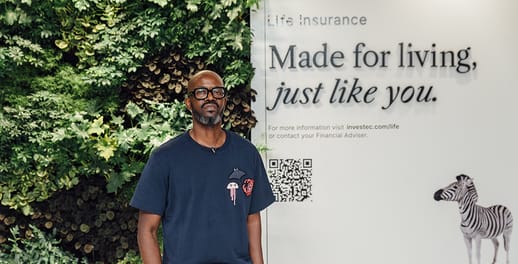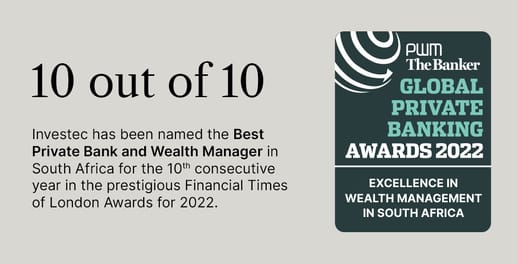Watch video
Listen on the go
In this podcast, Dr Frans Cronje, one of SA’s most successful scenario planners, Chris Holdsworth, Investec’s chief investment strategist, and Prof Mcebisi Ndletyana, UJ department of politics and international relations, discuss the various scenarios that could transpire in SA.
Is South African politics on the verge of a major, generational change? And could this change South Africa’s economic outlook for the better? These were some of the possibilities raised at a recent In conversation event hosted by Investec.
A panel made up of Mcebisi Ndletyana, professor of politics and international relations at the University of Johannesburg, Frans Cronje, an independent political analyst, and Chris Holdsworth, chief investment strategist at Investec Wealth & Investment SA, discussed South Africa’s political and economic outlook in the light of current global and local upheaval.
The event was moderated by Nozipho Tshabalala.
A coalition government in South Africa: closer than we thought?
Both Cronje and Ndletyana highlighted that should current political trends continue, the ANC could lose its absolute majority in Parliament in the 2024 elections. While this had the potential to create significant upheaval, it could signal that a ‘reform horizon’ was in reach, said Cronje.
Cronje argued that, according to recent polls, the ANC was likely to see its overall vote fall below 50%, meaning that coalition politics would come into play.
“With a bit more slippage economically, we put the ANC, let’s say, at 45% in the next election. The DA guys come in at about 25%, EFF sits just over 10%,” he said.
Prospects of a DA/ANC coalition
In such a scenario, Cronje said that one should not rule out an ANC/DA coalition, a view shared by Ndletyana.
“I think the DA is likely to be their (the ANC’s) partner of choice. Because both parties are kind of centrist parties, they share the same values and they also have a stake in the system. They are keen to make sure that things don't fall apart and they also respect business,” said Ndletyana.
“Business is part of the core of ANC supporters and they are very conservative. So the idea would be to come up with policies that will promote growth because for the ANC to lose power would be a serious psychological blow,” he argued.
Obstacles in the way of an ANC/EFF coalition
Both Ndletyana and Cronje said there were major obstacles in the way of an ANC/EFF coalition happening.
“I think the ANC doesn't like the EFF and feels they're a real threat to the stability of the country. The EFF presents a threat to their sense of prosperity, and they also are very conservative ANC folks,” said Ndletyana.
“Electorally speaking, the EFF will not gain that much because their voters are youthful and most of them, yes, they don't like the system, but they are not keen to vote,” he said.
Cronje added that public opinion in the main remains remarkably moderate compared to the sort of impressions created sometimes on social media and the mainstream media. This should provide support for a reformist agenda in Parliament and the Union Buildings after the current administration ends. “I think that's where we're headed: a broad front, with broadly reform-minded political organisations, who are going to learn to work together, being patient with each other in places like Johannesburg where things have broken down,” said Cronje.
“Public enthusiasm for coalitions is so strong, that if you cannot cooperate responsibly with your partners to the advantage of the greater whole, you will become politically irrelevant.”
The case for optimism about South Africa’s economic future
Economically too, there was some reason for optimism, argued Holdsworth, largely because of a ‘structural pessimism’ when it comes to looking at South Africa’s growth prospects, which creates opportunity. He explained his view as follows:
“If you look at IMF forecasts for GDP per capita growth, which is the key measurement of development over the next three years, it forecasts that we are going to be in the bottom 10% of countries every year for the next three years. But we've never been in the bottom 10% of countries for three years in a row.
“And it's because of forecasts like that, that South Africa surprises on the upside. Last year, we grew at 4.9%, which was more of an upside surprise than every other country we track. So far this year, we're growing at 2%. We think next year, we're going to grow from 1.5% to 2.5%, which aren't great numbers but they are more than our peers are doing. The US will grow at half a percent next year, and Europe will be lucky to grow at 0%. So we're growing by more than other countries, not less.
“But there is a structural pessimism in the forecast for South African growth. That means there's a lot of risk premium and that's where the opportunity lies. We've got to zig when everybody else is zagging, conditional on us having a reasonable outlook and that is our case.”
“We were able to cut our debt bill, while the rollout of the social grants programme, did extremely well in raising basic living standards. As a consequence, the country calmed down politically and the ANC was consolidating support, it was growing,” he said.
The energy transition
A second cause for optimism lies in the global drive to complete an energy transition and move away from fossil fuels to tackle climate change, as emphasised recently at COP27 in Egypt.
“We've seen commitments from various countries to get to net zero emissions by 2050, that's Europe and the US. 2060 in China, 2070 in India, we've [South Africa] said 2050. The European Parliament is now looking to ban all new internal combustion engine vehicles by 2035. So in 13 years, you won't be able to buy a petrol or diesel car in Europe, if this gets passed.
“To go down this path, you need a lot of metal [to make] electric vehicles, windmills, solar panels – they're very metal intensive. According to IMF estimates, by 2040, we would need to double copper production, we need four times as much nickel and we need 20 times as much lithium, for example. There are other commodities too.
“Meanwhile, the miners are not increasing production by enough – it takes 10 years to develop a copper mine, but there've been no major finds in the last few years. Either we're not going to go down this energy transition theme and we're going to be stuck with coal and gas, or we are going to see a massive squeeze in the prices of these metals. And that's an opportunity and we invest accordingly,” concluded.
Eskom’s finances
What then about the impediments to economic growth in South Africa in the coming years, such as the energy crisis affecting Eskom, as well as public services and state-owned enterprises?
Holdsworth argued that the government had the capacity to take on Eskom’s debt and that this could alleviate Eskom’s impact on the economy.
“The state is looking at taking on about R200 billion onto its balance sheet and that will allow for the unbundling of Eskom to be feasible. Each of the units will have low enough debt to be able to survive, in effect,” he said.
“Given that we've got R5 trillion worth of debt at the state level, the R200 billion isn’t a huge amount. It will take our debt-to-GDP ratio up by about 3%. But note that our debt-to-GDP trajectory has been consistently improving over each of the past couple of years, one of the few countries to have seen that. This year, government revenue surprised on the upside by R100 billion, so Eskom's debt is not a massively unaffordable number.”
The key, said Holdsworth, was the conditions that Treasury is going to attach. “We have seen some of that already, perhaps the request that Eskom goes down the nuclear path and the gas path, we have to see if that's acceptable or feasible,” he said.
Tackling South Africa’s unemployment challenges
Unemployment and inequality are also challenges weighing heavily on the current economic situation in South Africa. But they are not insurmountable, argued Cronje.
“The solution to that problem [poverty and the gap between rich and poor] is very high rates of growth,” argued Cronje, adding that South Africa’s GDP growth rate would need to be above 5% a year to make a dent to the rate of unemployment, which currently sits above 33% (with an even higher youth unemployment rate).
“That's not theory, that's our track record. In the first 15 years after 1994, when the growth rate was again allowed to lift and hit that 5% mark, the rate of unemployment fell from about 30% to just over 20%, and the number of people with a job doubled. The jobless growth story is just nonsense, it's not what happened through the Mbeki years.”
Cronje noted that during the South African economy’s period of high growth “all ships were lifted”.
“We were able to cut our debt bill, while the rollout of the social grants programme, did extremely well in raising basic living standards. As a consequence, the country calmed down politically and the ANC was consolidating support, it was growing,” he said.





